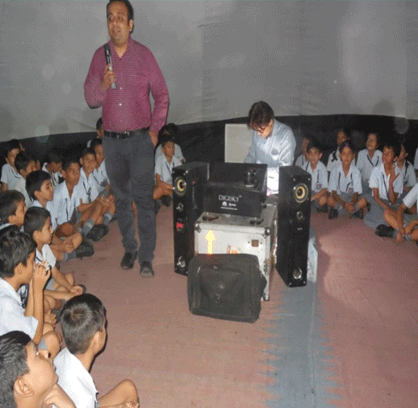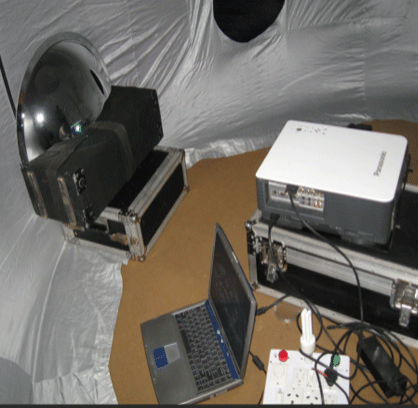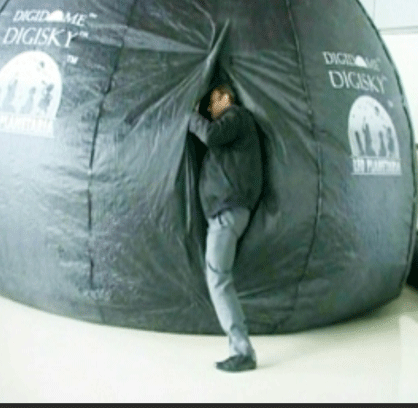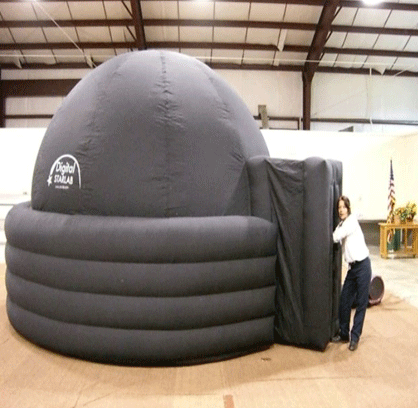Sales Overview
All DigiskyTM Planetarium Projection Systems available for sale or rental / hire are a single fisheye lens based full dome digital planetarium projection systems. A DigiskyTM system can be used with mobile as well as fixed domes of various sizes. It has a small foot print and is to be placed at the centre of a dome. Keeping in mind that the software technology evolves at a much faster pace, the system has modular design and thus easy to maintain and upgrade especially in the Indian context. The standard model that we offer is compatible for portable as well as fixed domes of sizes up to 7 meter diameter. Customized models for small as well as large domes up to 15 metre dome diameter are also available.
Our scope of supply for digital mobile planetariums or fixed planetariums primarily consists of following items/ software/ services:
- A full dome (no part of the sky missing) planetarium projector which consists of a high end professional grade digital projector.
- An input server with high end graphic card and processor and 5.1 audio output sound card.
- A robust back lit keyboard cum remote as a user interface.
- A tablet or PC or laptop based user interface.
- A real time render planetarium sky simulation software in Englis and various other Indian languages.
- Multimedia software which makes the entire system plug and play.
- Ready-made planetarium content library for, on the fly display on the dome.
- Up to four pre-recorded full dome shows for each class/ grade in suitable languages for schools (K12) with support books and class room based test for each planetarium show.
- Pre-recorded full dome shows in suitable languages for college students and general public.
- Forum Membership.
- A suitable audio system.
- A multi layered no crawl & no squeeze and pack-able fabric dome with a blower cum fan for mobile planetarium and an extra standby inner dome projection layer.
- A perforated aluminium sheet or fibre (FR) planetarium dome for fixed planetariums.
- Basic or Advance Training.
- Consultancy with conceptual drawings on how build a fixed planetarium for a school/ college/ university/ science centre/ museum/ fun park.
Difference between DigiskyTM Full Dome Planetarium and Mirror Dome Planetarium:
| DigiskyTM Full Dome Planetarium |
Mirror Dome Planetarium |
| Creates full sky, no part of the sky is truncated/ missing i.e. N/S/E/W directions and the entire sky above the horizon thus making it the most effective model of the sky or teaching aid for astronomy. |
Both the planetariums i.e. full dome and mirror dome use a hemispherical surface (dome) for projecting their content. However, part of the sky is truncated/ missing in a mirror dome planetarium (sic) thus defeating the very purpose of a planetarium as an effective teaching aid of astronomy. |
| In other words Full Dome means Full Sky. |
In other words Mirror Dome means Truncated Sky. |
| Following Motions and Grids that are prerequisite/ fundamental to understand or teach astronomy are demonstrated in the best possible way on a full dome through up to the mark sky simulation software. Diurnal, Annual, Retrograde, Precessional, Proper Motion of Stars, Ecliptic, Meridian, Celestial Equator, Circumpolar Stars, Tropic Lines, Alt/ Az Grid, Universal Grid, Galactic Grid, and Analemma. |
Since the sky is truncated and moreover no up to the mark sky simulation software is available for mirror dome, the prerequisite/ fundamental to understand astronomy cannot be demonstrated in the best possible way. |
| A full dome planetarium simplifies the complexity of the positional astronomy and various motions thus enabling students to grasp even complex astronomical concepts at an early stage and that too from altogether a different perspective. |
Not possible in mirror dome. |
| Primarily plays astronomy content that is exclusive/ applicable/ relevant to the model of the sky/ full dome and which otherwise is of almost no use when played on a flat screen. |
Primarily plays content that is for flat screen but is novel when played on a truncated dome i.e. unidirectional |
| It creates full immersive environment. |
It creates partial immersive environment that obviously is unidirectional. |
| Truly liberates the teaching fraternity from the practical and intrinsic limitations of star gazing. It is meant for Planetarium EducationTM. |
Truly speaking it is not a planetarium and primarily plays non astronomy content on novelty basis. It is not meant for Planetarium EducationTM. |
 |
 |
Difference between Analog Planetarium and DigiskyTM Digital Planetarium:
| Analog Planetarium |
DigiskyTM Digital Planetarium |
| It is like a typewriter. |
It is a computer like DigiskyTM. |
| Can only show the classical sky i.e. the sky that we see with naked eyes (about 3000 stars at a time). |
Can show the universe that is full of galaxies, stars,
nebula, star clusters and a lot more.
|
| Not possible in analog technology. |
Can show the universe in visible as well as invisible light (various parts of the spectrum). |
| Demonstrates only diurnal motion i.e. rise and set of celestial objects due to rotation of the Earth. |
Shows full suite of celestial motions i.e. Diurnal, Annual, Precessional, Retrograde, and Proper Motion of Stars. |
| Not possible in analog technology. |
Can show all astronomy events like Eclipses, Transits, Occultations, Conjunctions, Planetary Alignments and Meteors. |
| Not possible in analog technology. |
Can create skies from any location/ city (lat/ lon) on the Earth, from various other celestial bodies and from space from present, past and future. |
| Not possible in analog technology. |
Can show telescopic view of celestial objects and a whole lot more. |
| Not possible in analog technology. |
A digital planetarium by virtue of the technology is also used to play non astronomy content ranging from Earth Science to Biology to almost any other topic in a novel and simulating way. |
| Creates immersive environment. |
Creates 3D immersive environment. |
Difference between DigidomeTM for Mobile Planetariums and Crawl or Squeeze in Domes:
| DigidomeTM for Mobile Planetariums |
Crawl or Squeeze in Domes |
| Light weight; a typical 5 meter dia. dome weighs dia. dome weighs more less than 20 Kg. |
Heavy weight; a typical 5 meter than 35 Kg. With add on surrounding tubes the weight is even more. |
| Has less volume. |
Has less volume. |
| Occupies less floor area. |
Occupies more floor area. |
| Has much better ventilation through large multiple horizontal outlets tunnels at ground level that spread out like spider legs and vertical downward tunnels half way up the dome. |
Has poor ventilation as the tunnels are not well spread. Moreover there are no vertical downward tunnels on upward side of dome. |
| Has two separable layers namely the outer shell layer and the inner projection layer so that the inner projection layer can be serviced or replaced as and when required. |
No such provision so maintenance cost is higher. |
| Since there are two layers, pinhole light leakage is minimum. |
Since it is has a single layer, pinhole light leakage is common. |
| Cannot be installed outdoors. |
Cannot be installed outdoors in spite of the door and tubes. Door and tubes are more of cosmetic additions rather than having any practical utility. |
| Has lower entry/ exit transit time for audience. |
Has higher entry/ exit transit time for audience. |
| Has provision to attach a window air conditioner. |
No such provision. |
| Customer's logo can be printed on the dome at no extra cost. |
No such provision. |
| The entry/ exit vertical zippers blend with the inner projection dome layers. |
The doorway and its vents bulge out to the projection area causing visual disturbance. |
| If someone leaves in between a show or joins late the then the exit / entry will create disturbance for others. |
If someone leaves in between a show or joins late then exit / entry will not create any disturbance for others. |
| Is wheelchair accessible. |
Is wheelchair accessible. |
| Is much cheaper. |
Is much costlier. |
 |
 |








